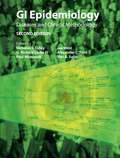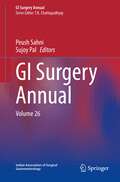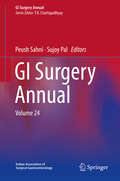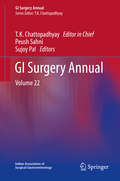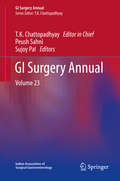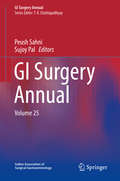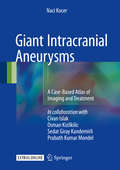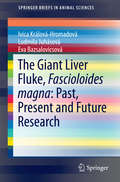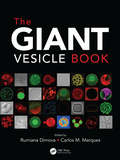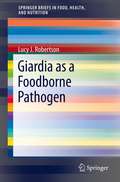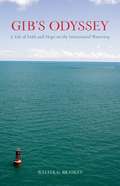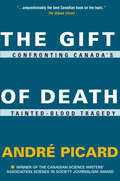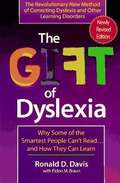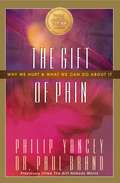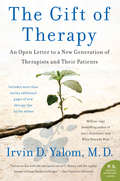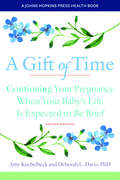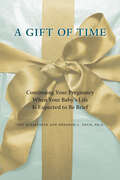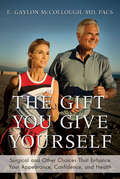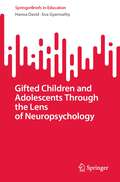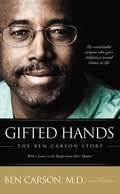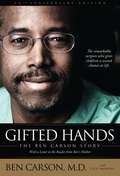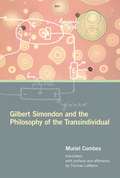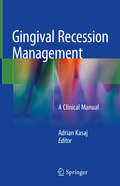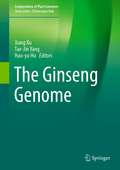- Table View
- List View
GI Epidemiology
by G. Richard Locke Yuri A. Saito Nicholas J. Talley Joseph J. West Paul Moayyedi Alexander C. FordThe only book to combine epidemiological analysis of gastrointestinal diseases with an examination of the methodologies of clinical research, GI Epidemiology, 2nd Edition, unites global experts to identify why and how GI diseases occur, to whom, and what can be done to prevent them. With new editors, new contributors, and a new, more user-friendly approach to epidemiology, this edition presents vital information in an accessible framework.
GI Surgery Annual: Volume 26 (GI Surgery Annual #26)
by T. K. ChattopadhyayThe twenty-sixth volume of GI Surgery Annual includes chapters on current and upcoming topics in gastrointestinal surgery pertaining to cholangiopancreatoscopy, robotic liver resections and transplants, primary familial intrahepatic cholestasis, managing a patient after total pancreatectomy, transplant immunology and immunosuppression as well as the chapter on advances in gastrointestinal surgery. The authors have expertise and excellent academic track record in the relevant subspecialties. Marrying academic excellence with publishing expertise is going to be the new mantra for the present as well as the upcoming issues of GI Surgery Annual.
GI Surgery Annual: Volume 23 (GI Surgery Annual #23)
by Sujoy Pal Peush SahniThe 24th volume of this highly successful series includes new contemporary topics such as corrosive injuries of the oesophagus, post-gastrectomy complications, advances in imaging of inflammatory bowel disease, unusual presentations of gallstones, gall bladder cancer with jaundice, minimally invasive pancreatic surgery, and enhanced recovery after surgery. Finally, the chapter on advances in GI surgery, like in each past volume, reviews important new developments in the field. The GI Surgery Annual 24th Volume provides an overall roundup of selected topics that were deemed particularly relevant and topical by the series editors.
GI Surgery Annual
by Peush Sahni Sujoy PalThe twenty-second volume of GI Surgery Annual covers a gamut of topics from oesophageal adenocarcinoma, to motility disorders of the colon and rectum, mesenteric tumours as well as the contemporary technique of ALPPS, acute portal vein thrombosis and small for size syndrome in live donor liver transplant. The chapter on advances in gastrointestinal surgery as every year reviews the important new information in the field in an easy to understand manner.
GI Surgery Annual
by Peush Sahni Sujoy PalThe 23rd volume of this highly successful series includes new contemporary topics such as PET in HPB diseases, short gut syndrome, current status of extended lymphadenectomy in esophageal cancer, splenectomy for haematological disorders, postoperative liver failure, HIPEC, and current issues in surgery of pancreatic cancer. Finally, the chapter on advances in GI surgery, like in each volume in the past, reviews the important new developments in the field. The GI Surgery Annual 23rd Volume provides an overall round up of selected topics that are considered relevant and contemporary by the editors of the series.
GI Surgery Annual: Volume 25 (GI Surgery Annual #25)
by Peush Sahni Sujoy Pal T. K. ChattopadhyayThe 25th volume of this highly successful series covers a range of interesting topics, including biological therapy in inflammatory bowel disease, recent surgical approaches in rectal cancer, tumor markers in HPB and GI malignancies, bridging therapy for hepatocellular carcinoma, adjuncts to liver resection, IgG-related HPB diseases, ERCP-induced perforations and superior mesenteric artery syndrome. As in the previous volumes, the chapter on advances in GI surgery reviews the important new developments in the field. The GI Surgery Annual 25th Volume provides up-to-date information on current hot topics.
Giant Intracranial Aneurysms
by Naci KocerThis atlas focuses on the imaging and treatment options available for giant intracranial aneurysms since 1990s in the beginning of the so-called modern endovascular era. During this period, there were significant advances made in the therapy of small intracranial aneurysms though the treatment of giant aneurysms continued to pose an insurmountable challenge. At the turn of this century, this grim scenario gradually improved with better understanding of the pathophysiology of giant intracranial aneurysms. This changed scenario in giant intracranial aneurysm therapy has been illustrated with the aid of informative clinical case studies. The clinical presentation of giant aneurysms in adults and children is described as are the merits of different imaging modalities explained and illustrated. Extensive consideration has been given to modern fusion imaging that has improved our insight into the nature of the disease. Endovascular treatment approaches (including illustrative open surgical approaches) and reconstructive and deconstructive strategies are fully documented, with careful attention given to factors that influence management strategies, treatment choice and complications. The atlas will be a valuable reference and practical aid for neuroradiologists, neurosurgeons, neurologists, fellowship trainees, postgraduate & graduate students.
The Giant Liver Fluke, Fascioloides magna: Past, Present and Future Research
by Ivica Králová-Hromadová Ľudmila Juhásová Eva BazsalovicsováThis monograph presents complex data on Fascioloides magna from all aspects of its research (general information, distribution, spectrum of hosts) and summarizes the latest information on molecular structure of informative genes which were recently applied in resolving taxonomy and biogeography of this veterinary important parasite. The giant liver fluke, Fascioloides magna, is important liver parasite of free-living and domestic ruminants. Due to its biology, distribution, medical impact, and invasive character, this liver fluke attracts attention of wide spectrum of specialists - veterinary doctors, hunters and farmers, as well as scientists. The parasite utilizes wide range of free living and domestic ruminants as definitive hosts, with various pathological impacts ranging from moderate infections towards lethal effects. Fascioloides magna is of North American origin where it occurs in five enzootic regions. It was introduced to Europe along with its deer hosts in 19th century and it has established three permanent natural foci. The giant liver fluke represents an outstanding model for studying the origin, spatial distribution, migratory routs, and invasion processes of introduced species.
The Giant Vesicle Book
by Rumiana Dimova Carlos MarquesGiant vesicles are widely used as a model membrane system, both for basic biological systems and for their promising applications in the development of smart materials and cell mimetics, as well as in driving new technologies in synthetic biology and for the cosmetics and pharmaceutical industry. The reader is guided to use giant vesicles, from the formation of simple membrane platforms to advanced membrane and cell system models. It also includes fundamentals for understanding lipid or polymer membrane structure, properties and behavior. Every chapter includes ideas for further applications and discussions on the implications of the observed phenomena towards understanding membrane-related processes. The Giant Vesicle Book is meant to be a road companion, a trusted guide for those making their first steps in this field as well as a source of information required by experts. Key Features • A complete summary of the field, covering fundamental concepts, practical methods, core theory, and the most promising applications • A start-up package of theoretical and experimental information for newcomers in the field • Extensive protocols for establishing the required preparations and assays • Tips and instructions for carefully performing and interpreting measurements with giant vesicles or for observing them, including pitfalls • Approaches developed for investigating giant vesicles as well as brief overviews of previous studies implementing the described techniques • Handy tables with data and structures for ready reference
Giardia as a Foodborne Pathogen
by Lucy J. RobertsonAlthough widely recognized as an important waterborne pathogen, Giardia duodenalis can also be transmitted by contamination of food. The same properties of this protozoan parasite that mean that water is an excellent transmission vehicle are also important for foodborne transmission. These include the low infective dose, the high number of cysts that are excreted, and the robustness of these transmission stages. However, many more outbreaks of waterborne giardiasis have been reported than foodborne outbreaks. This is probably partly due to epidemiological tracing being much more difficult for foodborne outbreaks than waterborne outbreaks, and the number of persons exposed to infection often being fewer. Nevertheless, the potential importance of foodborne transmission is gradually being recognized, and a wide range of different foodstuffs have been associated with those outbreaks that have been recorded. Additionally, various factors mean that the potential for foodborne transmission is becoming of increasing importance: these include the growth of international food trade, a current trend for eating raw or very lightly cooked foods, and the rise in small-scale organic farms, where there the possibility for contamination of vegetable crops with animal faeces may be greater.
Gib's Odyssey: A Tale of Faith and Hope on the Intracoastal Waterway
by Walter G. BradleyThis is the true story of an extraordinary man, Gib Peters, and his solo journey along the Intracoastal Waterway from Key West to New York and back while suffering the ravages of Lou Gehrig's disease. On an astonishing six-month voyage, Gib and his boat, Ka-Ching, encounter everything from an incompetent sailboat captain who lets his tow-rope wrap around Ka-Ching's propellers and when he dives into the water to cut it loose accidently stabs himself with his knife, to the Navy and Coast Guard Zodiacs rushing to stop him from entering a naval bombardment zone. Gib carries out epic searches for his two kittens when they go AWOL at an Atlantic City marina and when one later falls overboard. All the while, he is forced to cope with increasing levels of paralysis, steering the boat home with his feet and unable to speak. Authored by Gib's neurologist, Gib's Odyssey is told in Gib's own voice through a series of e-mails and articles he wrote for the Key West Citizen. Part travelogue, part soul-searching meditation, it is the uplifting and sometimes hilarious story of one man's conquest of death and his profound insights into life.
The Gift of Death: Confronting Canada's Tainted Blood Tragedy
by André PicardFew Canadians know of "Mr. L," an auto worker in Ontario who gave "the gift of life" in 1984 as part of a company blood donor drive. Many more will remember Kenneth Pittman, a 53-year-old heart patient, who died after being infected with AIDS -- from Mr. L's blood. They will also remember Mr. Pittman's wife, Rochelle, who contracted the virus from her husband because his doctor decided not to inform them of Mr. Pittman's fatal disease.This tragic story is a microcosm of Canada's blood scandal. For over a decade, bureaucratic dithering, profits-over-protection responses, a paternalistic medical establishment and uninformed victims combined to create the worst health-care disaster in Canadian history. More than 1,200 people have contracted AIDS from tainted blood -- and the dying continues.André Picard has produced the definitive analysis of this complex tragedy. All of the players are here -- public health officials who refused to take the "homosexual plague" seriously; the Red Cross, which worried about bad publicity and the bottom line; the too-little-too-late government that offered inadequate compensation for victims; and the arrogant medical establishment which sometimes took years to inform HIV patients of their condition; and most of all, the victims, who are paying for this betrayal with their lives.The Gift of Death is a call for a serious re-evaluation of an outdated blood system to ensure that a similar tragedy never occurs.
The Gift of Dyslexia: Why Some of the Smartest People Can't Read and How They Can Learn
by Ronald D. Davis Eldon M. BraunDavis shares the startling discovery he made which helped him overcome his own dyslexia, and reveals how dyslexia may be linked to uncommonly high levels of intelligence, creativity, and imagination.
A Gift of Hope: The Tony Melendez Story
by Tony Melendez Mel WhiteFrom the Publisher: The inspiring story of a young thalidomide victim and talented musician who has gained international recognition. Wonderful reading for anyone--especially those facing seemingly insurmountable difficulties. ... This is a beautifully, and positively, written autobiography. Melendez neither downplays his and his family's struggles resulting from his lack of arms, nor does he whine about them. Writing about his father, "Still, he knew that only in America would he find the kind of medical treatment I needed, so he put his own dreams aside and began to dream for me. He was young, strong, and determined to provide for each of us-but especially, I believe, for me. Imagine his growing frustration as he tried to support us on the minimum wage jobs that he could find. And there was no extra time or money to train in another field. [In Nicaragua, he was educated and accomplished in the fields of agriculture and animal husbandry.] Instead, he found himself in a huge pool of cheap labor as more and more unskilled young people migrated to America."
The Gift of Pain: Why We Hurt and What We Can Do About It
by Paul Brand Philip YanceyA WORLD WITHOUT PAIN? Can such a place exist? It not only can--it does. But it's no utopia. It's a colony for leprosy patients: a world where people literally feel no pain, and reap horrifying consequences. His work with leprosy patients in India and the United States convinced Dr. Paul Brand that pain truly is one of God's great gifts to us. In this inspiring story of his fifty-year career as a healer, Dr. Brand probes the mystery of pain and reveals its importance. As an indicator that lets us know something is wrong, pain has a value that becomes clearest in its absence. The Gift of Pain looks at what pain is and why we need it. Together, the renowned surgeon and award-winning writer Philip Yancey shed fresh light on a gift that none of us want and none of us can do without.
The Gift of Therapy: An Open Letter to a New Generation of Therapists and Their Patients
by Irvin YalomThe culmination of master psychiatrist Dr. Irvin D. Yalom's more than thirty-five years in clinical practice, The Gift of Therapy is a remarkable and essential guidebook that illustrates through real case studies how patients and therapists alike can get the most out of therapy. The bestselling author of Love's Executioner shares his uniquely fresh approach and the valuable insights he has gained--presented as eighty-five personal and provocative "tips for beginner therapists," including: Let the patient matter to you Acknowledge your errors Create a new therapy for each patient Do home visits (Almost) never make decisions for the patient Freud was not always wrong A book aimed at enriching the therapeutic process for a new generation of patients and counselors, Yalom's Gift of Therapy is an entertaining, informative, and insightful read for anyone with an interest in the subject.
A Gift of Time: Continuing Your Pregnancy When Your Baby's Life Is Expected To Be Brief (A\johns Hopkins Press Health Book Ser.)
by Amy Kuebelbeck And Deborah L. DavisA Gift of Time: Continuing Your Pregnancy When Your Baby's Life Is Expected to Be Brief
by Amy Kuebelbeck Deborah L. DavisA Gift of Time is a gentle and practical guide for parents who decide to continue their pregnancy knowing that their baby's life will be brief. When prenatal testing reveals that an unborn child is expected to die before or shortly after birth, some parents will choose to proceed with the pregnancy and to welcome their child into the world. With compassion and support, A Gift of Time walks them step-by-step through this challenging and emotional experience—from the infant's life-limiting prenatal diagnosis and the decision to have the baby to coping with the pregnancy and making plans for the baby’s birth and death. A Gift of Time also offers inspiration and reassurance through the memories of numerous parents who have loved a child who did not survive. Their moving experiences are stories of grief—and of hope. Their anguish over the prenatal diagnosis turns to joy and love during the birth of their child and to gratitude and peace when reflecting on their baby’s short life.Full of practical suggestions for parents and for caregivers, A Gift of Time also features the innovative concept of perinatal hospice and palliative care. Caring and thoughtful, the book helps parents embrace the extraordinary time they will have with their child.
The Gift You Give Yourself: Surgical and Other Choices That Enhance Your Appearance, Confidence, and Health
by E. Gaylon McColloughAn experienced cosmetic surgeon details surgical and holistic options to help readers achieve their ideal look.In a society driven by appearances, we all know the importance of looking our best. The cosmetic industry is overflowing with procedures, products, and plans that promise to help us achieve this goal. But true health, success, and confidence are more than skin deep. How can you determine which options are best for you?In The Gift You Give Yourself, Dr. E. Gaylon McCollough invites readers to become more informed and better prepared to develop a life plan personalized to their own goals. With more than three decades of experience in facial plastic surgery and Rejuvenology™, he not only reveals the secrets of plastic surgery but also explores how diet and nutrition, skin care, and understanding the mind/body connection can keep you feeling and looking your best for longer than you might have thought possible. Dr. McCollough’s highly successful holistic approach will leave you ready to embark on the journey to becoming—and remaining—the you of your dreams.Praise for The Gift You Give Yourself“Anybody who is thinking of having any procedure should read The Gift You Give Yourself.” —Paul Nassif, MD, star of TV’s Botched“I enjoyed the honesty of Dr. McCollough . . . he goes into every detail about why your body might be appearing to age quicker than others, and many times it is because of a vitamin deficiency. I like that he discusses surgical and non-surgical choices and lifestyles for even the average person to feel and look beautiful.” —San Francisco Book Review
Gifted Children and Adolescents Through the Lens of Neuropsychology (SpringerBriefs in Education)
by Hanna David Eva GyarmathyThis book addresses a wide range of issues situated in the core of theoreticians’ and clinicians’ work in the field of giftedness. It gathers practical issues, relevant for the lives of many gifted children, adolescents and adults, from a neuropsychological point of view. By studying the basic questions in gifted education through a neuropsychological lens, this book aims to establish a uniform new way for the treatment of gifted children with social or emotional difficulties, learning disabilities, physical limitations, or psychological and psychiatric disorders. This book helps educators and mental-health professionals to obtain a deeper understanding of the neurological system and its role in learning. This includes memory, knowledge-processing, making connections, and the implications on the cognitive, emotional, and physical aspects – all of which play major roles in the life of each gifted child and adolescent. By acquiring this new knowledge, more teachers, counsellors, psychologists and psychiatrists will be able to help individuals materialize their giftedness, while preserving their mental health and productivity.
Gifted Hands: The Ben Carson Story
by Ben Carson Cecil MurpheyBen Carson, M.D., works medical miracles. Today, he's one of the most celebrated neurosurgeons in the world. In Gifted Hands, he tells of his inspiring odyssey from his childhood in inner-city Detroit to his position as director of pediatric neurosurgery at Johns Hopkins Hospital at age 33. Ben Carson is a role model for anyone who attempts the seemingly impossible as he takes you into the operating room where he has saved countless lives. Filled with fascinating case histories, this is the dramatic and intimate story of Ben Carson's struggle to beat the odds -- and of the faith and genius that make him one of the greatest life-givers of the century.
Gifted Hands 20th Anniversary Edition: The Ben Carson Story
by Ben CarsonIn 1987, Dr. Benjamin Carson gained worldwide recognition for his part in the first successful separation of Siamese twins joined at the back of the head. Carson pioneered again in a rare procedure known as a hemispherectomy, giving children without hope a second chance at life through a daring operation in which he literally removes one half of their brain. Such breakthroughs aren’t unusual for Ben Carson. He’s been beating the odds since he was a child. Raised in inner-city Detroit by a mother with a third grade education, Ben lacked motivation. He had terrible grades. And a pathological temper threatened to put him in jail. But Sonya Carson convinced her son he could make something of his life, even though everything around him said otherwise. Trust in God, a relentless belief in his own capabilities, and sheer determination catapulted Ben from failing grades to the directorship of pediatric neurosurgery at Johns Hopkins Hospital in Baltimore, Maryland. Gifted Hands takes you into the operating room to witness surgeries that made headlines around the world—and into the private mind of a compassionate, God-fearing physician who lives to help others.
Gilbert Simondon and the Philosophy of the Transindividual
by Muriel Combes Thomas LamarreGilbert Simondon (1924--1989), one of the most influential contemporary French philosophers, published only three works: L'individu et sa genèse physico-biologique (The individual and its physico-biological genesis, 1964) and L'individuation psychique et collective (Psychic and collective individuation, 1989), both drawn from his doctoral thesis, and Du mode d'existence des objets techniques (On the mode of existence of technical objects, 1958). It is this last work that brought Simondon into the public eye; as a consequence, he has been considered a "thinker of technics" and cited often in pedagogical reports on teaching technology. Yet Simondon was a philosopher whose ambitions lay in an in-depth renewal of ontology as a process of individuation--that is, how individuals come into being, persist, and transform. In this accessible yet rigorous introduction to Simondon's work, Muriel Combes helps to bridge the gap between Simondon's account of technics and his philosophy of individuation. Some thinkers have found inspiration in Simondon's philosophy of individuation, notably Gilles Deleuze and Félix Guattari. Combes's account, first published in French in 1999, is one of the only studies of Simondon to appear in English. Combes breaks new ground, exploring an ethics and politics adequate to Simondon's hypothesis of preindividual being, considering through the lens of transindividual philosophy what form a nonservile relation to technology might take today. Her book is essential reading for anyone who wants to understand Simondon's work.
Gingival Recession Management: A Clinical Manual
by Adrian KasajThis book is designed to serve as a clear and concise clinical manual that covers all aspects of the current management of gingival recession, with a particular focus on surgical techniques with the adjunctive use of autogenous tissues or soft tissue substitutes for recession coverage. A structured overview of the various surgical techniques is provided with the aid of high-quality illustrations, delivering an evidence-based clinical treatment guideline. In addition, individual chapters are dedicated to the classification of gingival recession, etiology and prevalence, clinical examination and diagnosis, decision making, potential complications, and postsurgical care. Gingival recession is a common condition in the adult population and is related to several undesirable conditions such as unaesthetic appearance, root caries, and hypersensitivity. Periodontal plastic surgery is now an important tool in the armamentarium of the clinician treating gingival recessions, and practitioners at all levels will find this book to be an invaluable source of guidance.
The Ginseng Genome (Compendium of Plant Genomes)
by Jiang Xu Tae-Jin Yang Hao-Yu HuThis book represents the first comprehensive compilation of information on all aspects of the medicinal plant Panax ginseng, ranging from its botany to applied aspects in medicine and molecular breeding. In contributions by respected experts, it also discusses the genetic background and biochemical profile of this important medicinal plant. Ginsenoside biosynthesis and metabolic dynamics are also described in detail. Given its scope, the book offers a valuable guide for students, educators and scientists in academia and industry interested in medicinal plants and pharmacy.
